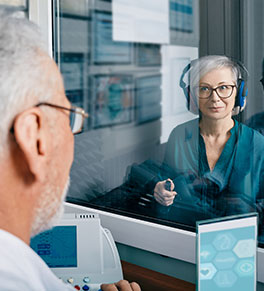Cochlear Implants
When a patient has total deafness very severe hearing loss, a cochlear implant is often recommended.
Cochlear implants function differently than hearing aids, which amplify sound. The implants replace hearing through the ears by taking sounds and sending those signals to the hearing nerve so the patient "hears."
The UCI Health cochlear implant team are leaders in the technology. Our team holds several patents in the design and invention of cochlear implants. They have also done pioneering surgery in the area, improving the quality of life and ability to hear to thousands of individuals. Learn more about our research.
How cochlear implants work
A cochlear implant has an external sound processor, which captures sound and converts it to digital signals.
Those signals are delivered to an internal implant. That implant converts the signal into an electrical impulse, which is sent to an array inside the cochlea.
Electrodes then stimulate the hearing nerve. The brain then picks up these signals, and sound is heard.
Who can have a cochlear implant?
Young children
- 12 months to 17 years
- Profound sensorineural hearing loss (nerve deafness) in both ears
- Lack of progress in development of hearing skills and language development with hearing aid
- High motivation and realistic expectations from family
- No other medical conditions that will interfere with the placement of the implant
Adults
- 18 years and over
- Severe-to-profound sensorineural (nerve deafness) hearing loss in both ears
- Receive little or no useful benefit from hearing aids
- Score 50 percent or less on sentence recognition tests in the ear to be implanted and 60 percent or less in the non-implanted ear or in both ears
Surgery
The surgery involves an approximately two-hour procedure with an incision behind the ear. A minimal amount of hair is shaved, which is generally not noticeable with hair worn down.
Some patients stay overnight in the hospital and are discharged the day after surgery after removal of the dressing. The pain is generally minimal after surgery.
The patients are seen after surgery and once everything is healed (a few weeks after surgery), the programming of the implant begins.
Programming
Once you have healed from the surgery, the process of activation and programming of the device begins. The initial activation is done about one month after surgery. Follow-up visits at three, six, nine, and twelve months are required for further fine-tuning of the implant sound quality.
After the first year, at least one visit a year is needed to insure best performance or for updates in software. For children, more visits are required for rehabilitation.
You may decide to participate in one of our many clinical research projects for improvement of the quality of the implant.
Recovery
Once you start hearing with the cochlear implant, the brain needs to learn to understand the sounds that are heard through the implant. Initially, speech sounds differently from the way you used to hear.
The process of training the brain to learn the hearing process with the implant is the rehabilitation. While some patients can understand speech well immediately after the initial stimulation and programming, it generally takes some time for the brain to get used to the new way of hearing.
The best way to speed up the rehabilitation process is to use the implant during all waking hours of the day. Sometimes, more frequent visits are required for the rehabilitation.
For children, weekly visits are required for speech and language training.








